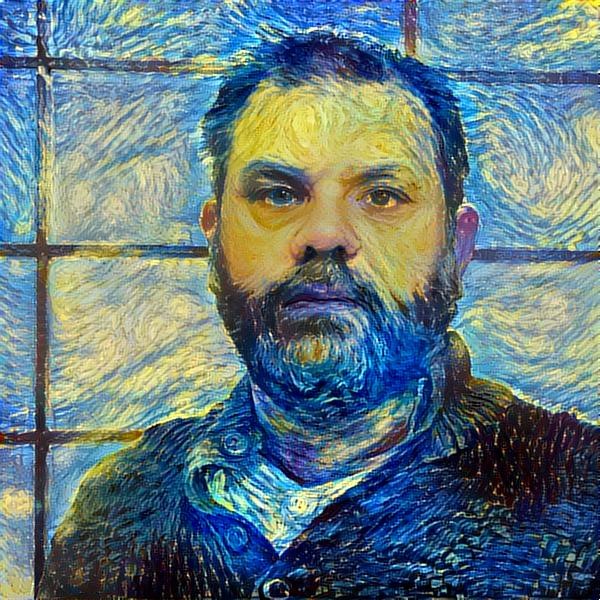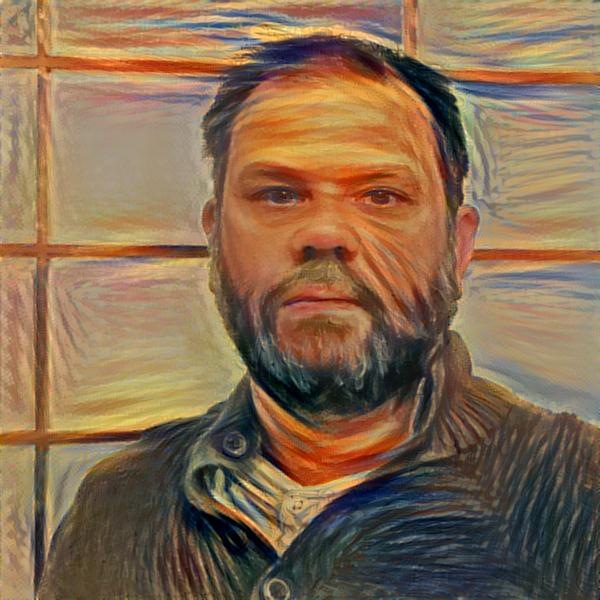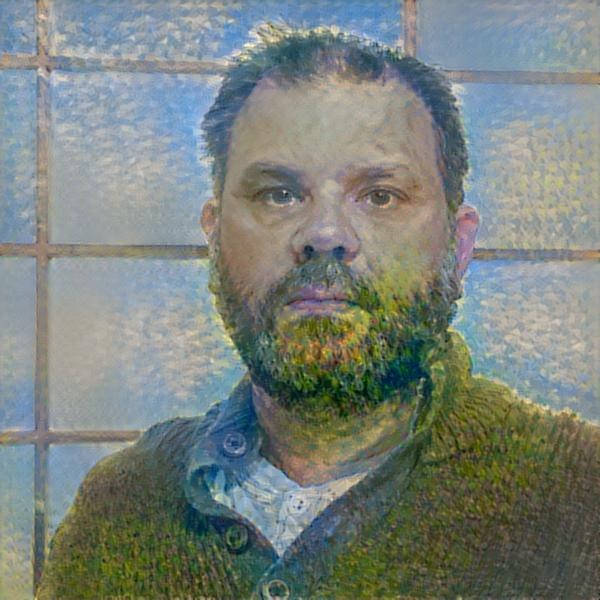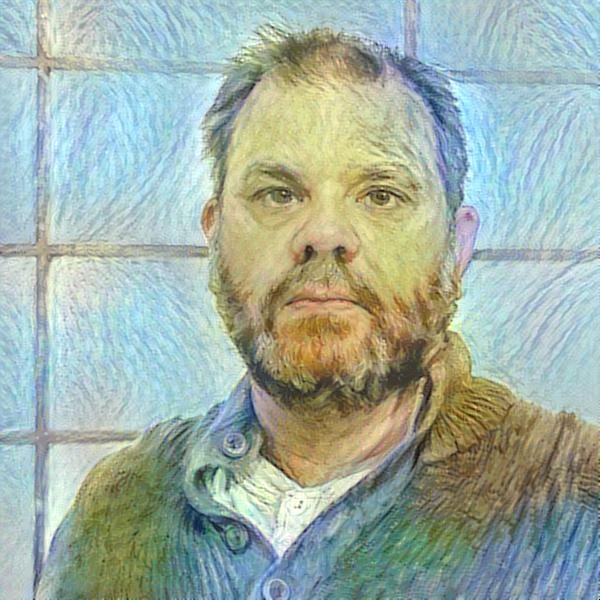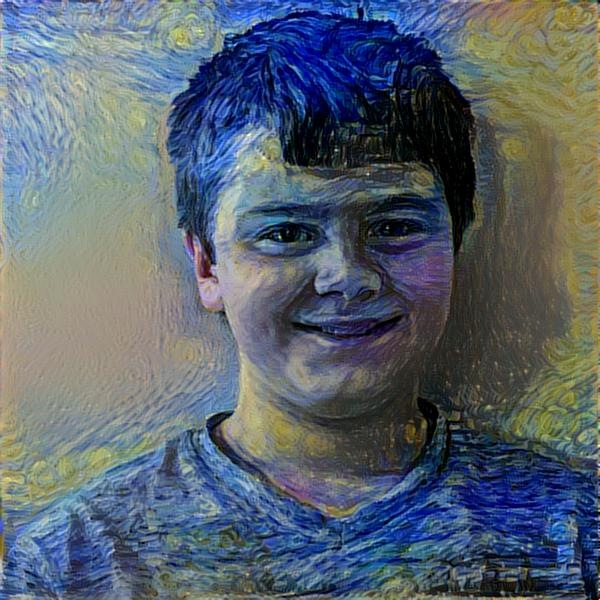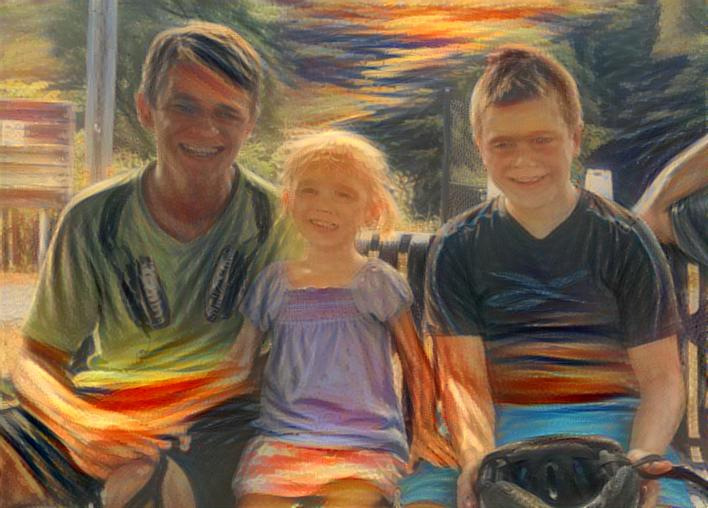Applying Style Transfer to Portraits
Hunter and I have been focusing on reverse engineering the three most famous paintings according to Google as well as a hand selected piece from the National Gallery. These art works are The Mona Lisa, The Starry Night, The Scream, and Woman With A Parasol.
We also just recently got Style Transfer working on our own Tensor Flow system. So naturally we decided to take a moment to see how a neural net would paint using the four paintings we selected plus a second work by Van Gogh, his Self-Portrait (1889).
Below is a grid of the results. Across the top are the images from which style was transferred, and down the side are the images the styles were applied to. (Once again a special thanks to deepdreamgenerator.com for letting us borrow some of their processing power to get all these done.)
It is interesting to see where the algorithm did well and where it did little more than transfer the color and texture. A good example of where it did well can be seen in the last column. Notice how the composition of the source style and the portrait it is being applied to line up almost perfectly. Well as could be expected, this resulted in a good transfer of style.
As far as failure. it is easy to notice lots of limitations. Foremost, I noticed that the photo being transferred needs to be high quality for the transfer to work well. Another problem is that the algorithm has no idea what it is doing with regards to composition. For example, in The Scream style transfers, it paints a sunset across just about everyone's forehead.
We are still in processing of creating a step by step animation that will show one of the portraits having the style applied to it. It will be a little while thought cause I am running it on a computer that can only generate one frame every 30 minutes. This is super processor intensive stuff.
While processor is working on that we are going to go and see if we can't find a way to improve upon this algorithm.
A Deeper Learning Analysis of The Scream
Am a big fan of what The Google Brain Team, specifically scientists Vincent Dumoulin, Jonathon Shlens, and Majunath Kudlar, have accomplished with Style Transfer. In short they have developed a way to take any photo and paint it in the style of a famous painting. The results are remarkable as can be seen in the following grid of original photos painted in the style of historical masterpieces.
However, as can be seen in the following pastiches of Munch's The Scream, there are a couple of systematic failures with the approach. The Deep Learning algorithm struggles to capture the flow of the brushstrokes or "match a human level understanding of painting abstraction." Notice how the only thing truly transferred is color and texture.
Seeing this limitation, I am currently attempting to improve upon Google's work by modeling both the brushstrokes and abstraction. In the same way that the color and texture is being successfully transferred, I want the actual brushstrokes and abstractions to resemble the original artwork.
So how would this be possible? While I am not sure how to achieve artistic abstraction, modeling the brushstrokes is definitely doable. So lets start there.
To model brushstrokes, Deep Learning would need brushstroke data, lots of brushstroke data. Simply put, Deep Learning needs accurate data to work. In the case of the Google's successful pastiches (an image made in style of an artwork), the data was found in the image of the masterpieces themselves. Deep Neural Nets would examine and re-examine the famous paintings on a micro and macro level to build a model that can be used to convert a provided photo into the painting's style. As mentioned previously, this works great for color and texture, but fails with the brushstrokes because it doesn't really have any data on how the artist applied the paint. While strokes can be seen on the canvas, there isn't a mapping of brushstrokes that could be studied and understood by the Deep Learning algorithms.
As I pondered this limitation, I realized that I had this exact data, and lots of it. I have been recording detailed brushstroke data for almost a decade. For many of my paintings each and every brushstroke has been recorded in a variety of formats including time-lapse videos, stroke maps, and most importantly, a massive database of the actual geometric paths. And even better, many of the brushstrokes were crowd sourced from internet users around the world - where thousands of people took control of my robots to apply millions of brushstrokes to hundreds of paintings. In short, I have all the data behind each of these strokes, all just waiting to be analyzed and modeled with Deep Learning.
This was when I looked at the systematic failures of pastiches made from Edvard Munch's The Scream's, and realized that I could capture Munch's brushstrokes and as a result make a better pastiche. The approach to achieve this is pretty straight forward, though labor intensive.
This process all begins with the image and a palette. I have no idea what Munch's original palette was, but the following is an approximate representation made by running his painting through k-means clustering and some of my own deduction.
With the painting and palette in hand, I then set cloudpainter up to paint in manual mode. To paint a replica, all I did was trace brushstrokes over the image on a touch screen display. The challenging part is painting the brushstrokes in the manner and order that I think Edvard Munch may have done them. It is sort of an historical reenactment.
As I paint with my finger, these strokes are executed by the robot.
More importantly, each brushstroke is saved in an Elasticsearch database with detailed information on its exact geometry and color.
At the conclusion of this replica, detailed data exists for each and every brushstroke to the thousandth of an inch. This data can then be used as the basis for an even deeper Deep Learning analysis of Edvard Munch's The Scream. An analysis beyond color and texture, where his actual brushstrokes are modeled and understood.
So this brings us to whether or not abstraction can be captured. And while I am not sure that it can, I think I have an approach that will work at least some of the time. To this end, I will be adding a second set of data that labels the context of The Scream. This will include geometric bounds around the various areas of the painting and be used to consider the subject matter in the image. So while The Google Brain Team used only an image of the painting for its pastiches, the process that I am trying to perfect will consider the the original artwork, the brushstrokes, and how brushstroke was applied to different parts of painting.
Ultimately it is believed that by considering all three of these data points, a pastiche made from The Scream will more accurately replicate the style of Edvard Munch.
So yes, these are lofty goals and I am getting ahead of myself. First I need to collect as much brushstroke data as possible and I leave you now to return to that pursuit.










